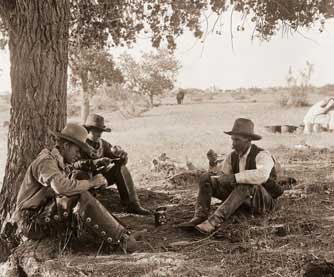
HALF BREED: FAMOUS IN TEXAS HISTORY
By Bob Jamison
The illegitimate son of his father and a young Cherokee Indian woman, this daring swashbuckling adventurer paved a trail through Texas and northward to Kansas that carries his name today. It is indelible in the minds of the very young cowboys and historians alike. His name was Jesse Chisholm.
But Jesse didn’t just happen to set up shop by dragging wagon loads of goods from Texas to Kansas to sell wares to starving cattle wranglers hungry for food and tobacco. He left rather hurriedly from his home in New Orleans with a price on his head! His crime: He fell in love with the beautiful daughter of a powerful N.O. gambler. The far thinking entrepreneur realized an opportunity when thousands of Longhorn cattle were being driven to Kansas. The reason was very simple. Cattle in Texas would bring $4.00 per head. The stock yards in Kansas paid $40.00 each.
These cattle drives would test the mettle of many a young cow pokes, many of which were in their teens. They felt bullet proof at that age and some were even tested as such. Other problems included vicious weather changes in which they had to face the natural elements. Also the constant threat of stampedes and attacks by outlaw rustlers, unfriendly farmers, unfriendly Indians who objected not being paid ten cents per cow using their grazing land on the way to Kansas, but many other dangers as well.
Drowning was not uncommon at all. They must swim cattle through countless creeks and rivers and accidents did happen. Likely the worse crossing was the very dangerous Red River not far from Bowie, Texas in Montague County. The Indians used this crossing because the certain bend in the river caused the current to be reduced somewhat. Other problems happened when the quick sands trapped both cattle and cowboy’s horses in the muck.
The stampedes were a common threat. It required a veteran cowboy and a dependable lead steer that would give direction to the herd. This might seem strange but one method of calming the heard by the lead cowboy was music. He would often croon a soft wordless song that might remind you of Eddie Arnold’s cattle call or Gene Autry’s, Midnight on the Prairie. There also was the proverbial fiddle player. As they bed the cattle down for the night, the fiddler would retrieve his violin from the chuck wagon. Certainly, he wouldn’t think of an up beat tune like Turkey in the Straw, but a soft melodious tune that would tend to calm the cattle as they grazed.
The Kansas stockyards soon became the topic of every cattle owner in Texas and beyond. That price of $40.00 was real and they wanted part of it. Joseph McCoy saw the opportunity to buy Texas cattle and knew that the Texas Longhorn breed of cattle had the stamina to make the long exhausting trip. It worked. The first year around l867 McCoy received and shipped northward 35,000 head of those cattle. Then O. W. Wheeler and partners brought in another 2400 head. Overall, there was an estimated 5,000,000 head of cattle to reach Kansas over the Old Chisholm Trail.
After Jesse Chisholm’s death in l868, the cattle drives continued until about l887 with the arrival of the Missouri-Kansas-Texas Railroad (commonly know as the Katy Railroad).
On those trains, there was often a young local cowboy from Brazoria County. He rode with those train loads of cattle to Kansas. Each time the train stopped for water or resting, the cowboys would be required to walk the cattle cars and poke up all that had fallen or just laid down. Thus, the name of “cow poke” probably came about. That particular cowboy was named William Thomas Jamison (l878-l962), father of this writer.